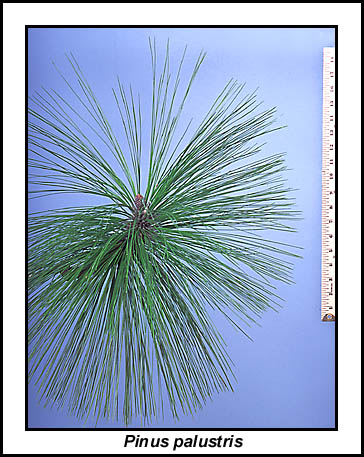Longleaf Pine
Pinus palustris
Family: Pinaceae
Natural History

Needles of longleaf pine | Photo credit: Larry Korhnak, University of Florida
Longleaf pine is the legendary southern yellow pine of forest history. While the tall, stately longleaf pine once covered 30 to 60 million acres of the southeastern United States Coastal Plain, 200 years of logging and land clearing have greatly reduced its range.
Longleaf pine takes 100 to 150 years to become full size, and can live to 300 years old. Modern methods of reforestation are helping to restore longleaf pine to previously cleared land. In the future, we may expect to see more of these majestic trees in the Florida landscape.
Unlike most conifers, the first three to seven years of longleaf pine growth do not involve stem elongation. Rather, it remains a fire resistant, stemless, dense cluster of needles resembling tufts of grass. The best way to differentiate longleaf pine in the grass stage from true grass species such as wiregrass (Aristida stricta) is to identify the longleaf’s thick, silver-white growth candle. The similar-colored buds 1 ½ to 2 inches long remain a good identifying characteristic in larger specimens.
During the grass stage, seedlings are developing a deep taproot system below the ground, and are capable of sprouting from the root collar if its top is damaged. The thick, silver-white hairs found on the buds during this stage in the longleaf’s life cycle provide resistance to fires.
Once the root system is thoroughly established, the tree begins normal stem elongation and its sprouting ability sharply increases. The taproot is usually eight to 12 feet long upon maturity. In early growth (up to eight feet high), the seedlings become susceptible to fire damage. Once longleaf pines reach eight feet in height, it is again fire resistant. The thick, reddish-brown, scaly bark of mature trees provides resistance by insulating the tree from the heat of fires.
Longleaf pine is one of many species that thrive when periodic low-intensity fires burn through stands. The fires keep invading hardwood species from taking over the stand, and simultaneously clear the ground of debris to allow for proper seed dispersal and germination.
